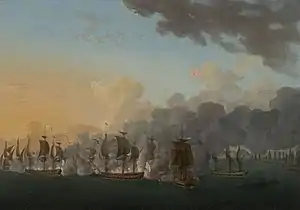Rupert George
Admiral Sir Rupert George (August 1747, St. Stephen’s Green, Dublin, Ireland – 25 Jan 1823, Willesden, London Borough of Brent, Greater London, England) was British naval officer in the American Revolution, became the Commodore for the Royal Navy's North America Station (1792-1794). He then returned to England and became the first Commissioner of the Transport Service, where he stayed for 22 years.[1]

He was the eldest son of Denis George and Sarah Young. In addition to their house at St. Stephen's Green the family had a country estate at Clophook near Stradbally, County Laois. Denis George, Recorder of Dublin and later one of the Barons of the Court of Exchequer (Ireland), was his younger brother.
American Revolution

George became a Lieutenant serving on the Rose (1770), Enterprise (1775) and Robust (1779).
In the American Revolution, he fought on the Quebec with Captain George Farmer in the Action of 6 October 1779. The following year he sailed on the HMS Griffin and captured the French Privateer 'Le Général Villepatoux'.[2] In February 1781, he commanded the Avenger.[3] In 1781, he was the captain of the Vulture, where he fought in the Battle off Cape Breton.[4]
On 12 August 1781, while commanding the Charleston, George captured the privateer Harlequin.[5] In November he was promoted to captain.[6] While in command of the Charleston, on 21 February 1782 took over Nararro and Philadelphia. In March he captured the de la Floride-Orientale and de la Georgie.[7] He later joined the Thisbe (1790), which he sailed out of Nova Scotia.
French Revolutionary Wars
From 1792 to 1794, during the French Revolutionary Wars, George served as the Commodore of the North America Station, commanding His Majesty's Naval Force on the Coasts of Nova Scotia and New Brunswick.[8] He commanded the only ship of war attached to the North America Station.[9][10] He sailed the Hussar (1792) out of the Mediterranean for Newfoundland. In March 1792 he captured two privateers, Republicaine and Jou-Jou.[11] On 12 May, he arrived with the new Governor, John Wentworth after a five week crossing from Falmouth.[12][13][1][14][15][16][4] In May 1793, he captured the St. Pierre.[17][18]
The first press warrant granted in Nova Scotia was in April 1793, when Wentworth granted a warrant to Commander Rupert George of HMS Hussar. George sent press gangs from Hussar into Halifax. In one night they detained 50 to 60 men, including several Liverpool mariners, and brought them aboard Hussar.[19]
He was promoted to Chairman of the Transport Board (1795). He served in the position for 22 years, through seven administrations (until 1817). During this time he was responsible for the "care and custody" of the French prisoners of war held in the Norman Cross Prison.[20][21][22][23][24] He was knighted in 1803 and created a baronet (1809).[4]
Family
He was buried in a vault at the centre of the plot in front of the portico of St Mary's Church, Battersea, England. (Also buried in the vault are Nova Scotians John Inglis and George's wife Margaret Cochran, daughter of Thomas Cochran by his first marriage.[25] Bishop Inglis also has a monument in the north gallery of the church.)[26][27]
His oldest son Samuel Hood George was sent to Nova Scotia (where his mother's family still lived) with the new Governor Sir George Prevost to become the Provincial Secretary (1808-1812), after which he returned to England and died (1813).[28]
His second oldest son Sir Rupert Dennis George then departed for Nova Scotia to take his older brother's position as Provincial Secretary (1813-1827). He also became the second and last Baronet (1813). He also was the Aide-de-camp during Lt. Gov. Sir Peregrine Mailand's command of the Nova Scotia militia.[29] (Joseph Howe was the next Provincial Secretary and complained about George's handling of the position.)[30]
Links
References
- "Sir Rupert George".
- "French Privateer 'Le Général Villepatoux' (1780)". threedecks.org.
- p. 157
- Sutcliffe, Robert K. (March 19, 2016). British Expeditionary Warfare and the Defeat of Napoleon, 1793-1815. Boydell & Brewer. ISBN 9781843839491 – via Google Books.
- British Warships in the Age of Sail 1714-1792: Design, Construction, Careers ... By Rif Winfield, p.1781
- https://archive.org/details/politicalindext02beat/page/53/mode/1up/search/%22Rupert+George%22?q=%22Rupert+George%22
- https://babel.hathitrust.org/cgi/pt?id=njp.32101076536380&view=1up&seq=378
- Women's Canadian historical society of Toronto. Transaction no. 1-10, p. 20
- p. 59
- p. 245
- p. 214
- p. 100
- https://archive.org/details/collectionsofnov20nova/page/n146/mode/1up/search/George?q=%22Rupert+George%22
- "The gentleman's magazine. Volume 93 (Being the Sixteenth of a New Series. Part the First.), January - June 1823". London : E. Cave. March 19, 1731 – via Internet Archive.
- Eaton, Arthur Wentworth Hamilton (March 19, 1899). "The Cochran-Inglis family of Halifax". Halifax, N.S. – via Internet Archive.
- "Sir Rupert George, first baronet". lordbyron.org.
- p. 32
- Akins in his history of Halifax errors, indicating the George's son is the captain of the Hussar.
- Keith Mercer, "Northern Exposure: Resistance to Naval Impressment in British North America, 1775–1815," Canadian Historical Review, June 2010, Vol. 91 Issue 2, p. 222.
- p. 865
- https://babel.hathitrust.org/cgi/pt?id=hvd.hnf23u&view=1up&seq=370
- https://babel.hathitrust.org/cgi/pt?id=uc2.ark:/13960/t85h7f53f&view=1up&seq=61
- https://archive.org/details/politicalindext02beat/page/110/mode/1up/search/%22Rupert+George%22?q=%22Rupert+George%22
- The depot for prisoners of war at Norman Cross, Huntingdonshire 1796 to 1816 by Walker, Thomas James, p.142
- p. 108
- Obit - Margaret
- "The Project Gutenberg eBook of All About Battersea, by Henry S. Simmonds". www.gutenberg.org.
- p. 9
- https://archive.org/details/militiaofnovasco0000edwa/page/22/mode/1up/search/%22Rupert+George%22?q=%22Rupert+George%22
- Joseph Howe - Amherst
| Baronetage of the United Kingdom | ||
|---|---|---|
| New creation | Baronet (of Park Place and St Stephen's Green) 1809–1823 |
Succeeded by Rupert George |